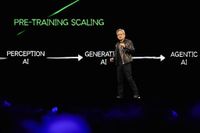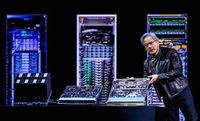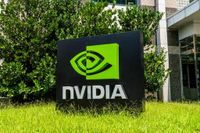Nvidia stock experienced a modest rebound this week as optimism grew around the company’s prospects in artificial intelligence (AI) and data center spending following its annual Graphics Technology Conference (GTC) keynote. Shares of the chipmaker rose over 2% on March 19, 2025, recovering from a prior two-day slide that saw the stock drop 5% after the keynote presentation didn't generate as much excitement initially among investors.
Analysts from Wall Street, however, emerged from CEO Jensen Huang's keynote with renewed optimism. They have reiterated their bullish ratings on Nvidia. For instance, Citi analyst Atif Malik stated, “We came out of the keynote reassured in NVIDIA's leadership which if anything seems to be expanding,” maintaining his Buy rating with a price target of $163. Similarly, Raymond James analyst Srini Pajjuri echoed this sentiment, holding onto his Strong Buy rating and showcasing confidence in sustained AI demand.
During his highly anticipated address on March 18, Huang laid out Nvidia's ambitious roadmap for the coming years, stating that the company plans to release three critical AI chip models: Blackwell Ultra in the second half of 2025, Vera Rubin in the latter half of 2026, and Vera Rubin Ultra in late 2027. Huang articulated an optimistic vision, predicting that data center spending in compute hardware could reach a staggering $1 trillion, urging confidence in the future of AI technologies.
“I've said before that I expect data center build-out to reach $1 trillion. And I am fairly certain we're going to reach that very soon,” Huang told attendees, emphasizing the growing importance of AI and the increasing specialization of hardware needed to power these technologies.
The confidence expressed by Huang at the GTC presentation has led analysts to conclude that Nvidia’s roadmap is not only solid but is also increasing the company’s competitive edge over its rivals. Bernstein's Stacy Rasgon commented on this development, stating, “The roadmap looks really solid, and their capability gap vs competitors across their entire massive stack continues to widen.”
Nvidia's stock has shown resilience amidst market fluctuations, and analysts believe several Nvidia partners also benefited from the bullish sentiments. On March 19, 2025, Coherent's stock surged nearly 7%, while Supermicro and Amphenol stocks gained close to 6% each, as Nvidia's strong performance and its plans for the future indicated boosted business opportunities for its partners and suppliers.
However, despite the positive outlook following the GTC event, Nvidia shares experienced a minor decline in premarket trading on March 20, 2025, as analysts from Morgan Stanley expressed a more positive stance on Nvidia’s trajectory, reflecting a mixed investor sentiment around Nvidia stocks.
Jensen Huang tackled more than just stock speculation during his presentation. He addressed the misconception surrounding AI spending—particularly the fears surrounding new, lower-cost AI models that could potentially hinder investment in infrastructure. Addressing this concern, he stated that “data center spending plans from cloud service providers may appear cautious, but they do not account for significant new builds from initiatives like Stargate and xAI. Enterprises are gearing fully towards establishing their own AI factories.”
Nvidia is preparing to scale up its manufacturing capabilities in the U.S. Huang revealed that Taiwan Semiconductor Manufacturing (TSMC) is already running production silicon for Nvidia’s upcoming chips at its Arizona facility. This is part of Nvidia’s broader strategy to establish a robust domestic supply chain for semiconductor manufacturing.
For the stock market watchers, the impact of Nvidia's GTC conference was felt as demand for Nvidia's GPUs remains remarkably high. Wedbush analyst Daniel Ives noted, “The demand for Nvidia GPUs remains extremely robust,” emphasizing a staggering demand-supply ratio of 15:1. Ives indicated that more enterprises are waiting to get their hands on Nvidia's cutting-edge AI chips, further reinforcing the company’s market stronghold.
Huang's unveiling of Nvidia’s next-generation AI processor not only captivated attendees but also underlined Nvidia's commitment to innovation. Alongside detailed future product releases, Huang introduced new technology, including inferencing software called Nvidia Dynamo, designed to enhance AI capabilities while aiming to reduce operational costs.
Nvidia's technological advancements extend into networking as well, with the introduction of new networking switches using silicon photonics technology—an innovation expected to substantially reduce energy consumption in data centers.
Analysts are bullish on Nvidia, as evidenced by recommendations and raised price targets following the GTC event. Evercore ISI analyst Mark Lipacis pointed out, “No one is investing at the pace or magnitude Nvidia is in building out a full-stack chip+hardware+networking+software ecosystem for the AI computing era,” emphasizing Nvidia's clear competitive edge. Meanwhile, Cash flow projections show Nvidia could experience capital expenditures in data centers scaling from $500 billion in 2025 to $1 trillion by 2030.
As investors absorbed the insights from Huang’s presentation, Nvidia's narrative of innovation and leadership in AI continued to gain momentum—a testament to a technology landscape that remains vibrant and ever-changing. Huang's assertion that “if you are building a data center today, there is only one option,” rings true as Nvidia sustains its competitive stronghold against emerging technologies and competitors.
Overall, Nvidia stock interpreted the outcomes of the GTC keynote with a bounceback in the market, reflecting both the enduring demand for their technology and Huang’s persuasive vision for the future—a future that appears to remain brightly illuminated by the advancements in artificial intelligence.







